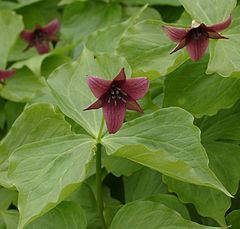Trillium erectum
| Habit | herbaceous
| |
|---|---|---|
| Height: | ⇕ | 20 in"in" can not be assigned to a declared number type with value 20. |
| Width: | ⇔ | 20 in"in" can not be assigned to a declared number type with value 20. |
| Lifespan: | ⌛ | perennial |
| Bloom: | ❀ | early spring, mid spring, late spring |
| Exposure: | ☼ | part-sun, shade |
|---|---|---|
| Features: | ✓ | flowers |
| Minimum Temp: | ☃ | -35°C-31 °F <br />238.15 K <br />428.67 °R <br /> |
| USDA Zones: | 4 to 9 | |
| Flower features: | ❀ | red, pink |
|
Trillium > |
erectum > |
L. > |
Trillium erectum, also known as Wake-robin, red trillium, purple trillium, Beth root or Stinking Benjamin, is a spring-flowering perennial plant native to the east and north-eastern areas of North America. The flowers are a deep red colour, and the plant takes its name Wake-robin by analogy with the Robin, which has a red breast that heralds spring.
This plant grows to about 40 cm in height with a spread of 30 cm and can tolerate extreme cold in winter, surviving temperatures down to -35 C. The flowers have the smell of rotting meat, as they are pollinated by flies. The leaves contain calcium oxalate crystals and crystal raphide, and should not be consumed by humans.
Read about Trillium erectum in the Standard Cyclopedia of Horticulture
|
|---|
|
Trillium erectum, Linn. (T. pendulum, Willd. T. purpureum. Kin. T. foetidum, Salisb. T. atropurpureum, Curtis). Stout, 1 ft. or more high: lvs. broadly rhombic-ovate: pedicel usually bent over or inclined but sometimes erect: fls. brown-purple to greenish purple, the petals usually about 1 in. long, ovate to lanceolate, not much if any exceeding the sepals. Nova Scotia to Man., N. C. and Mo.—The fls. of T. erectum are ill-smelling. Var. album, Lodd., has white fls. Var. viridiflorum. Hook. Fls. greenish. Not known to be in the trade. CH
|
Cultivation
- Do you have cultivation info on this plant? Edit this section!
Propagation
- Do you have propagation info on this plant? Edit this section!
Pests and diseases
- Do you have pest and disease info on this plant? Edit this section!
Species
Gallery
References
- Standard Cyclopedia of Horticulture, by L. H. Bailey, MacMillan Co., 1963
External links
- w:Trillium erectum. Some of the material on this page may be from Wikipedia, under the Creative Commons license.
- Trillium erectum QR Code (Size 50, 100, 200, 500)


